Review of the Canon EOS R
Introductory Comments
This is very much a technical review, so rather than describing the handling of the camera and its various features (which can all be found elsewhere) I am more concerned about the technical characteristics that will affect long exposure astrophotography. In many cases I will be comparing it to the Nikon Z6 which I also own and which has a recent Sony sensor.
All my tests were done using a telescope or a (legacy) non-CPU lens. Since the lens (and telescope) is unrecognised by the camera firmware this means it is unable to make any hardcoded corrections.
For all tests, noise reduction, lens corrections and dual pixel mode were all switched off in the camera menus.
On the subject of dual pixels, the Canon EOS R mirrorless shares the same sensor as the Canon 5D mark iv DSLR, where every pixel is a dual pixel.
Since Canon's EOS Ra astro-camera is essentially the same camera but with different internal filtering (to enhance H-alpha sensitivity) I would expect my analysis to apply equally well to the (now discontinued) EOS Ra.
Read Noise Gain etc.
I don't intend to duplicate Bill Claff's excellent work at PhotonsToPhotos because I obtain very similar figures:
- Read noise: Canon EOS R vs Nikon Z6
- DxOMark Derived Characteristics: Canon EOS R vs Nikon Z6
Regarding the DxOMark Derived Characteristics, note that Bill says that fitting the DXO data has its limitations, affecting estimates of gain, read noise, QE etc.
The read noise has the typical Canon characteristic of being constant for 3 consecutive ISOs. I would therefore stick to the main ISO values i.e. 100, 200, 400, 800, 1600, 3200 etc. and avoid the intermediate ones.
It's worth pointing out that the bias level at ISO 100 and ISO 200 is 512 which is different from the bias of 2048 at higher ISOs.
It can be seen from the PhotonsToPhotos that the Canon EOS R read noise is noticeably higher than the typical Sony sensor at the ISOs most likely to be used for astrophotography i.e. ISO 800/1600. However, for long exposure RGB imaging the read noise is usually swamped by the noise of the background sky so read noise is not a concern. On the other hand, low read noise might be important if short exposures are being used or if narrowband filters are being used.
Dark Current and Camera Self-Heating
My methodology for testing dark current and self-heating is to put the camera in a dark room at 20C ambient temperature and leave it to acclimatise for an hour or two. I then switch the camera on and immediately run a couple of hours of consecutive 5 minute dark frames with the rear LCD folded out from the rear of the camera to allow heat dissipation. By subtracting each frame from the previous one, the thermal noise can be calculated and ultimately converted into dark current.
Here's the result for a few cameras, measured in electrons per pixel per second:
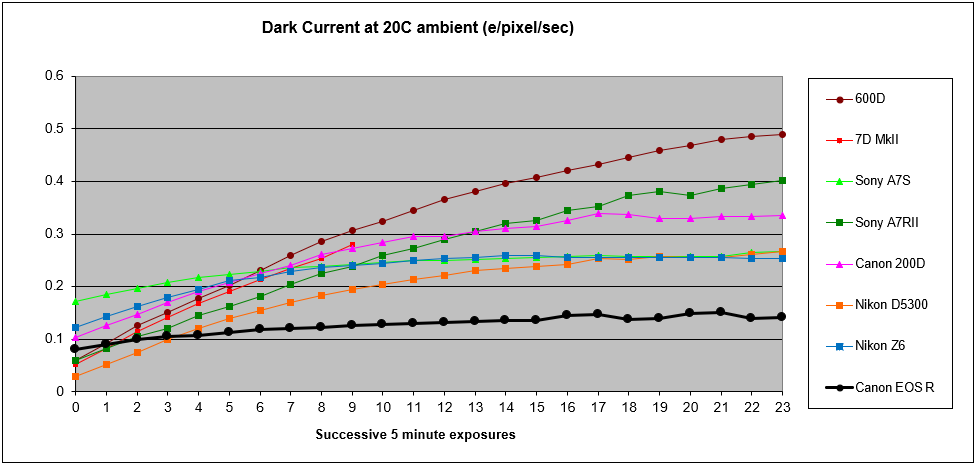
However, a lot of the difference is caused by the size of the pixels, so I find it's more meaningful to display the graph in terms of electrons per square micron per second:

It can be seen that the EOS R has low dark current and remarkably low self-heating during an extended session of long exposures. Remember also that during an actual imaging session the self-heating should be lower because the camera is thermally attached to a potentially heavy telescope and also the wind will be circulating the air around the camera body, both of which will have a cooling effect.
However any time spent in live view will potentially heat the sensor quite rapidly so live view should be kept to an absolute minimum to prevent any heat building up. Beware if you are controlling the camera from a laptop via USB because live view will be on continually. I therefore switch the tethered camera off unless actively focusing or framing the shot.
Banding and PDAF stripes
Horizontal banding problems are well known on many Canon cameras and they will often appear in the final stacked image. I did a lot of testing of this on the Canon EOS R. The only banding I found was positioned randomly from one frame to the next in a sequence of exposures. The amplitude of the banding was 1 ADU or less. Hence at typical astro-imaging ISOs 800/1600 the amplitude of the banding is buried in the read noise and stacking doesn't reveal it because the randomness causes it to cancel out.
I found no evidence of any horizontal banding in any of my master bias, master dark and master flat files and not in any of my final ISO 1600 stacked images.
In addition I found no stripes or bands caused by the PDAF (phase detection auto-focus) pixels, which is well known problem on the Nikon Z6, for example. This may be because every pixel on the EOS R is a dual pixel and so the sensor is homogeneous.
One annoying attribute of Sony full-frame sensors is the vertical "seam" down the centre of the sensor. This leads to artefacts near the centre line on both the Sony A7S and Nikon Z6 that never calibrate properly. I found no such evidence of a vertical discontinuity with the Canon EOS R.
Histograms, RGB Channel Scaling and Concentric Coloured Banding
The Canon EOS R appears to perform digital scaling (known as white balance pre-conditioning) to the colour channels, which leaves regularly spaced gaps in the histogram of the green and blue channels.
For instance, here's a histogram of a 5 minute dark frame at ISO 1600:
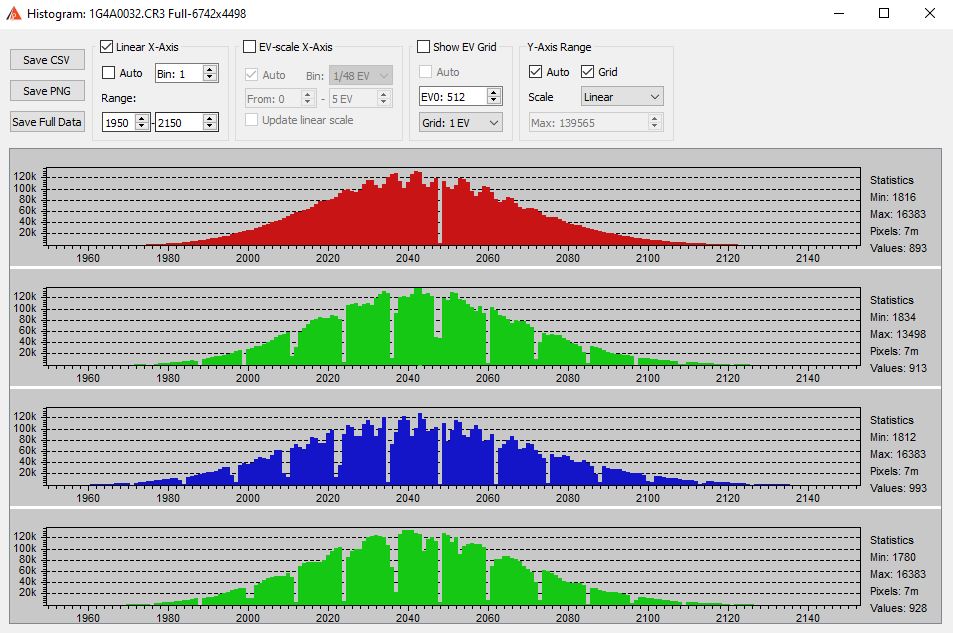
The red channel appears to be unaffected by the scaling which is different to Nikon where the green channel is untouched. This scaling of the channels is verified by the calculation of gain (e/ADU) which shows a different gain for each channel. However the scaling is relatively well behaved and my testing showed no evidence of concentric coloured banding of the type found on the Sony A7S, for instance.
The channel scaling is the cause of the oscillations seen in green and blue channels of the EOS R ISO 100 photon transfer curve: Canon EOS R Photon Transfer Curve However these oscillations are small. At higher ISOs these oscillations more or less completely disappear.
There was a Cloudy Nights thread on the Canon EOS Ra which discussed concentric rings: Canon EOS Ra Testing Further analysis showed that these rings are not caused by the channel scaling. It's possible that the cause is some kind of automatic lens correction applied to lenses recognised by the camera firmware but it's not something I am in a position to test and it therefore remains an open question.
There was a another type of concentric ring mentioned in that thread, caused by spikes in the red histogram. I found similar spikes in the EOS R histogram of a flat frame at ISO 100, near the values 1750 and 2350:

When this flat frame was used to calibrate another flat frame, two concentric rings did appear in the red channel, at positions that corresponded to values of 1750 and 2350:
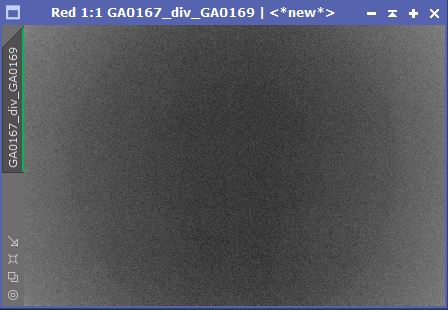
I really don't understand the cause of those spikes and initially I found it impossible to cause the associated rings to appear at ISO 800 and above. Unfortunately, a subsequent imaging session showed clear evidence of rings at ISO 1600.
Raw data filtering
Raw data filtering in cameras can cause a range of effects including:
- Damage to small tightly focused stars (i.e. "star-eater")
- Colour bias in small tightly focused stars - turning them green or magenta
- Ineffective calibration with master dark frames
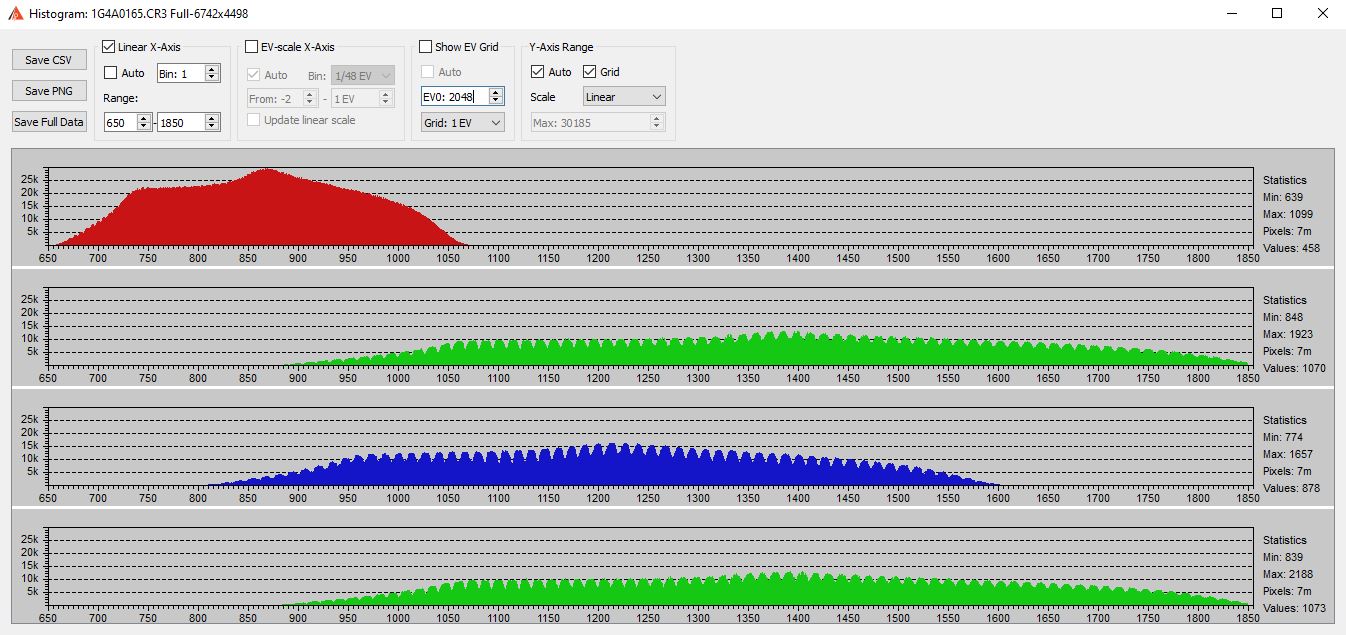
Here the green and red channel histogram gaps have become a pattern of scallops.
Despite weird patterns in the histograms I found no evidence of Canon EOS R destructive raw data filtering. Raw data filtering generally caps outlier pixel values to prevent them causing obvious noise in an image. It can be detected by comparing every pixel value against the maximum of their neighbours.
Here is a plot from a Canon EOS R ISO1600 5min dark frame:

It looks perfect! Note the strong vertical "arm" on the left. These are isolated bright pixels that have not been capped to the values of their neighbours i.e. no evidence of data filtering.
I also performed a FFT (Fast Fourier Transform) of a dark frame and this showed no evidence of high frequency filtering.
In addition, unlike my Nikon Z6, my Nikon D5300 etc., the Canon EOS R master dark frame calibrates the light frames perfectly. Dark calibration is very effective and well worth doing on this camera.
Electronic Shutter
The Canon EOS R has an electronic (silent shutter) mode. On some cameras this can compromise the bit depth of the data, giving 12 bits instead of 14 bits. This is not the case on the Canon EOS R (nor the Nikon Z6). It is therefore safe to use electronic shutter with no fear of loss of image quality or unwanted image artefacts. Electronic shutter prevents wear and tear on the mechanical shutter and it also allows very accurate fast exposures e.g. for taking flat frames against a bright sky.
However, beware that the slow scan speed of the electronic shutter (reported to be around 1/15sec) can cause horizontal banding with the fluctuating cycle of artificial lights. This is one reason I use sky flats.
QE (Quantum Efficiency)
On a clear sunny day I was able to test the EOS R and Nikon Z6 on exactly the same DIY spectrometer (a cardboard tube with a razor blade slit, diffraction grating and built in lens) pointing at a white target illuminated by direct sunlight.
The pixel values are converted into electrons using the gain for that colour channel and then adjusted for pixel area so we are comparing like with like i.e. photons recorded per unit area of sensor. Here is the result:

A note of caution is needed when interpreting this chart. The chart cannot be used to compare the QE of the sensor at the blue end of the spectrum against the red end. The blue channel climbs higher than the red simply due to the spectral composition of the daylight being reflected off the white (or whitish) surface the spectrometer was pointing at. However, at any individual wavelength the chart can be used to compare the response of the Canon EOS R against the Sony sensor in the Nikon Z6.
The overall shape of the curves is very typical of the difference between Canon and Sony sensors. In the red channel it is clear that the EOS R has a lower H-alpha response than the Z6. In fact it is around 80% of the Z6 response. On the other hand, the EOS R has a higher response at the H-beta and OIII wavelengths than the Z6. In all three colour channels the EOS R peaks at a lower level than the Z6 and overall the EOS R has a lower QE than the Z6.
One thing worth pointing out is that the lower H-alpha response does not necessarily mean the sensor is less sensitive but it could be caused by differences in the internal filter cut offs.
Bill Claff calculates some QE figures from the DxOMark data on PhotonsToPhotos.net and the difference I see between the EOS R and Z6 is broadly in line with what he calculates. It is sometimes claimed that DSLR and Mirrorless cameras have lower QE than dedicated one-shot-colour astro-cameras by erroneously comparing PhotonsToPhotos QE figures against the figures quoted by the astro-camera suppliers. But astro-camera suppliers are quoting peak response whereas the figures on PhotonsToPhotos are necessarily some kind of average over the green channel.
Sensor Linearity
The question here is the linearity of the sensor response to incoming light i.e. are the mean values recorded by the pixels directly proportional to the incoming light.
In common with many (or all) cameras the Canon EOS R does not have a completely linear response. This is evidenced by taking two flats at different exposure lengths in quick succession and then dividing one by the other. Here is the result of dividing two EOS R (bias-subtracted) ISO 1600 sky flats shot with different (electronic) shutter speeds:
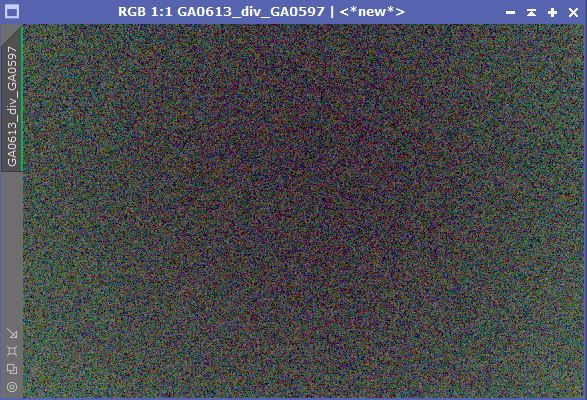
Notice the overall colour variations from the centre out towards the edges. Obviously this image has been highly stretched in order to show the effect, so although it looks dramatic the actual non-linearity is less than 1%. But 1% is enough to cause noticeable calibration difficulties when stretching the data to reveal faint structures for integration times of many hours.
Another contributory cause is pixel crosstalk whose effect potentially differs across the sensor according to the angle of incidence of the primary rays and the amount of vignetting towaqrds the edges of the sensor.
In any case the impact of non-linearity and pixel crosstalk on calibration by flats can be mitigated by taking flats with the same colour and intensity as the background night sky as described in this thread: Colour Matched Flats - A Case Study
Sample Images
Here are a couple of EOS R images I have shot and processed:

North America Nebula NGC7000

Iris Nebula and surroundings
The Iris Nebula image required a huge amount of stretching to bring out the faint dust in the neighbourhood of the Iris Nebula and therefore needed flats of the same colour and intensity as the background night sky.
Conclusion
I am very impressed by the Canon EOS R and it has now become my camera of choice for imaging deep sky objects.
Despite the higher read noise and the lower QE of the Canon sensor used in the EOS R (compared with typical recent Sony sensors) I have found this camera gives me image data that are far easier to process than either the Nikon Z6 or Sony A7S, resulting in a higher quality final image.
Last updated by Mark Shelley: 20 October 2023 (astro@markshelley.co.uk)